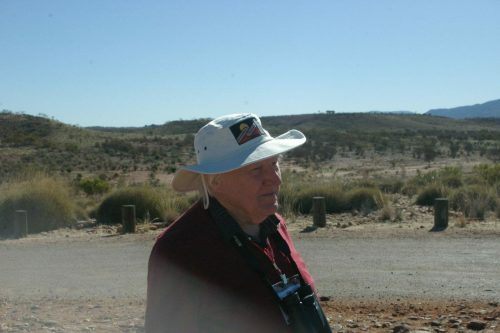Mervyn Paterson

What an amazing experience it has been to know Mervyn Paterson and to learn from him over several decades.
I have a short story to recount about Mervyn, involving red wine (of course), spectacular rocks, and Mervyn’s engineering design skills.
Back in 1986, on my first stint at ANU, Mervyn decided we should do a road trip in his car, from Canberra to Adelaide, to join a field excursion to look at the mid- to deep crustal geology of the Eyre Peninsula in South Australia. We left Canberra early in the morning with the intention of stopping overnight in Mildura, before heading on to Adelaide the next morning – that first leg was meant to be about 800 km, with about 400 km for the final leg. However, when we got to Mildura late in the day, Mervyn enquired whether I had enough stamina left to drive a further 200 km to Renmark. He suggested there was a very nice motel to stay there overnight. So, after 1000 km of driving, we eventually made it to Renmark in time for a very enjoyable (and much deserved!) dinner.
Next morning Mervyn was very keen to set off early, even though we had plenty of time to reach Adelaide. This was a puzzle to me. It was not until I was driving through the famous vineyards of the Barossa Valley that the reason for our early departure from Renmark became apparent. Mervyn suddenly suggested I take the next right turn off the highway onto a lane, as we had plenty of time for him to catch up with an old friend. That old friend turned out to be the notable winemaker, Peter Lehmann! So, much of the morning was spent tasting some wonderful wines. Unfortunately for me, I was the designated driver, so really got to taste only a few wines, whilst Mervyn allowed himself a much wider range. It was a delightful morning, with Peter Lehmann telling me much about blending of reds and proffering tastes of some outstanding experimental wines. At the end of the visit, I discovered the real reason for driving to Adelaide, rather than flying – Mervyn had planned to purchase a few cases of wine at much reduced price from our host. And getting them back to Canberra by car was certainly the best option! Being a good planner, he also left space to buy many more cases in Adelaide, so that his Canberra cellar could be adequately re-plenished with some very good South Australian wine!
Anyway, we eventually pushed on to Adelaide, met up with the other field trippers, and flew across to Port Lincoln on the Eyre Peninsula where we had many convivial days exploring spectacular geology in coastal outcrops. One day, Mervyn and I were looking at a beautiful mylonite zone, marvelling at the very high shear strains and associated fabrics. Mervyn suddenly remarked, in a very serious tone, that his current rigs really couldn’t achieve more than about 20% shortening, and were really not good enough to explore the strength and mechanical behaviour of rocks at “real” geological strains! He went on to conclude that he had better design a new machine that could do really high torsional strains. I’m sure this must have been on his mind for some years beforehand. But as soon as he got back to Canberra, Mervyn began producing drawings that eventually led to the commercial development of the ground-breaking Paterson torsional apparatus. The story also illustrates Mervyn’s great interest in exploring rocks in the field and asking himself how to quantify their strength and mechanical behaviour.
Mervyn was a truly exceptional scientist and engineer with enormous intellect, patience and humanity. He shared ideas and his knowledge freely, and was always a most gentle and modest character. I will greatly miss sharing morning tea conversation with him at RSES, as was our habit in the past few years.
Vale Mervyn! You have positively influenced the lives and careers of many students and colleagues. Your legacy will be long-lasting.
The photo below might be of interest to a few. It is of Mervyn on a field excursion in Central Australia in 2007, still enjoying looking at nature’s rock deformation experiments, some 17 years into his “retirement”.
